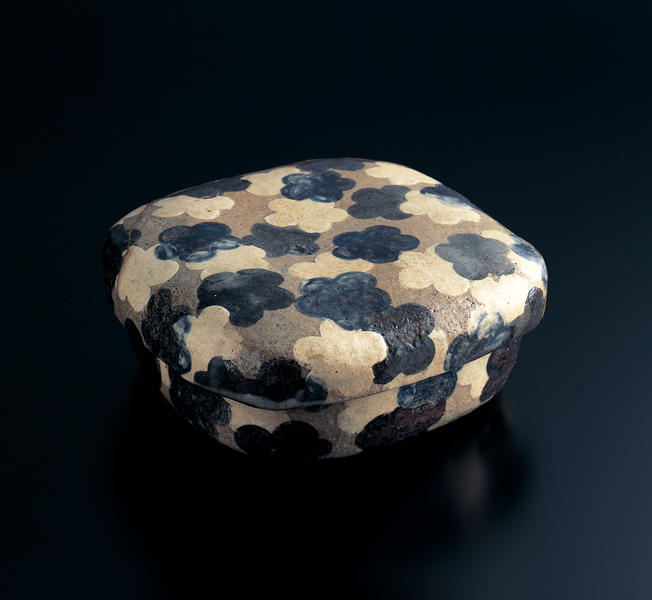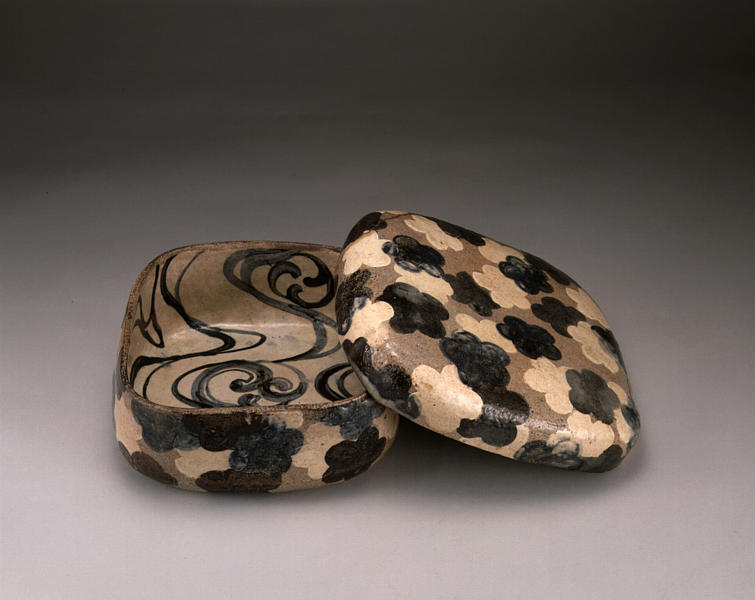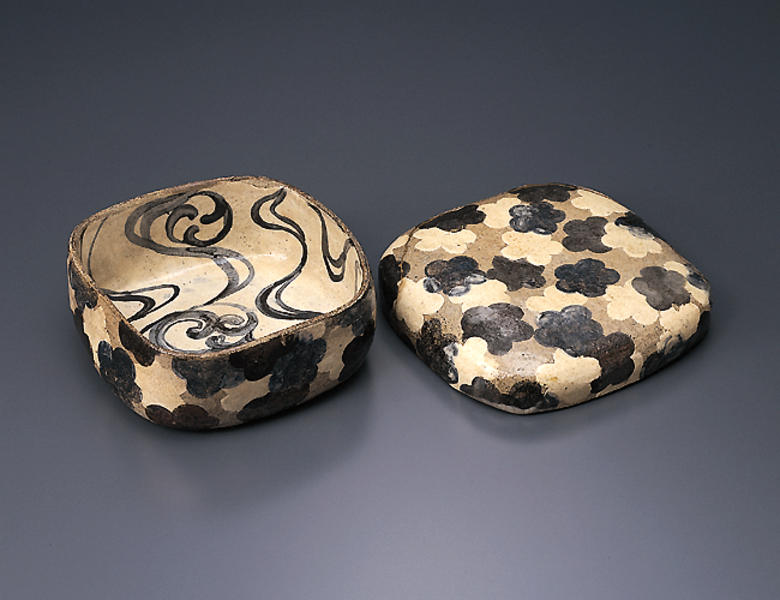乾山銹絵染付梅波文蓋物
- 京都・鳴滝
- 江戸時代
- 18世紀
- 乾山陶製、呉須染付、鉄絵
- H-8.6 D-21 W-20.5
江戸時代 18世紀
高:8.6cm 幅:20.5cm 奥行:20.5cm
外面には,素地の上に型紙摺りの要領で白泥の梅花が散らされ,重なる梅花を銹絵と染付で描き込んでから,透明釉が掛けられている。内面には,白泥で全面白化粧した上に染付で流水文が描かれ,外面と同様に透明釉が施されている。透明釉は器表面のほぼ全面を覆っているが,口縁部だけは露胎になっている。
この作品自体には「乾山」の銘はないものの,かつて大阪の鴻池家に伝来していた乾山焼のなかに,ほぼ同形・同大で外面の施文に同じ梅花形の型紙を用いている類品がある。その底部に比較的古相を示す「乾山」の銹絵銘があるので,この作品についても乾山焼とみなして問題はないと思われる。
白泥や下絵付けの隙間から透明釉を透かして見える胎土は,鳴滝の窯から破片が出土している銹絵百合形向付と類似しており,類品に見られる「乾山」銹絵銘が古相を示すものであることを考え合わせると,この作品は乾山焼としては比較的早い時期の製作である可能性が高いと思われる。 (尾野)
尾形乾山
尾形乾山(おがたけんざん 1663~1743)
乾山は、寛文3年(1663)京都の富裕な呉服商尾形宗謙(おがたそうけん)の三男として生まれました。兄は画家の光琳です。二人の性格は対象的で、光琳が派手好みであったのに対し乾山は内省的、隠遁的な性格の持主であったといわれています。
野々村仁清に陶芸を学んだ乾山は、元禄12年(1699)37歳のとき京都市の鳴滝に開窯しました。そして正徳2年(1712)50歳の乾山は、京市内の二条丁子屋町に移住し、多くの作品を手がけ「乾山焼」として世にもてはやされました。鳴滝時代の末期からこの丁子屋町時代にかけて兄の光琳は絵付で乾山を助け、兄弟合作の作品が数多く残されています。
享保16年(1731)69歳の頃に江戸に下り寛永寺(かんえいじ)領入谷(いりや)に窯を築いて晩年を送りました。そして81歳で没するまで江戸に在住し陶器や絵画の制作に手腕を発揮しました。
乾山の作品は陶芸作品のみならず書や絵画においても、俗気を脱したおおらかで文人的な洒脱味があります。陶芸作品においては成形、施釉、焼成は他の専門的な陶工に任せたり、絵付についても光琳との合作以外に複数の専門画家が携わっていたと思われるなど、基本的には工房生産という態勢をとっていたようです。しかし、乾山の指導のもとにつくられたやきものには、その大胆なデザイン感覚とともに乾山特有の芸術性が溢れ、乾山その人とふれあうような親しみが感じられるのです。
乾山銹絵染付掻落絵替汁次
乾山立鶴図黒茶碗
乾山銹絵染付桔梗図筒向付
乾山銹絵染付草文四方鉢
乾山銹絵染付松図茶碗
乾山色絵短冊皿
乾山銹絵絵替長平皿
乾山色絵寿字輪花向付
乾山銹絵絵替四方皿
乾山銹絵染付絵替筒向付
乾山銹絵染付松図茶碗
乾山色絵椿文向付
乾山銹絵染付春草図茶碗
乾山銹絵染付藤図向付
乾山色絵立葵図向付
乾山色絵雪杉図向付
乾山色絵桔梗文盃台
乾山銹絵馬図香合
乾山銹絵染付絵替扇形向付
乾山銹絵掻落雲唐草文大鉢
乾山銹絵草花波文水指
乾山銹絵染付絵替土器皿
乾山色絵槍梅図茶碗
乾山黒楽梅図茶碗
乾山銹絵染付芙蓉図茶碗
銹絵掻落牡丹唐草文香合
撫子図(尾形乾山筆)
乾山色絵和歌陶板
乾山色絵竜田川図向付
乾山銹絵牡丹画角皿 尾形光琳画
乾山銹絵百合形向付
乾山銹絵松文香合
乾山色絵阿蘭陀写市松文猪口
乾山色絵薄図蓋茶碗
乾山銹絵菊図水指
鶴亀図黒茶碗
紅葉図 尾形乾山筆
三十六歌仙絵/在原業平像 尾形乾山筆
三十六歌仙絵/斎宮女御像 尾形乾山筆
乾山色絵菊文手付汁次
三十六歌仙絵/小野小町像 尾形乾山筆
乾山銹絵染付山水図茶碗
Catalogue Entry
Edo period, 18th century
Kenzan ware, underglaze iron and blue
Height, 8.6cm; width, 20.5cm; depth, 20.5cm
A stencil paper was laid on the plain ground of the exterior of this box, and plum blossoms created in white slip were scattered over the entire surface. Then underglaze iron and blue pigments were used to draw in overlapping blossoms, and finally the entire piece was coated in transparent glaze. White slip was used to coat the entire interior of the box, and a wave pattern was drawn in underglaze blue on top of the slip, and then the interior was finally covered, like the exterior, with a transparent glaze. This transparent glaze covers almost the entire vessel surface, with only the rim of the mouth left un-glazed.
While this work does not have a Kenzan signature, a similar work of almost the same size and shape and also decorated on its exterior with a plum blossom motif created through paper stencils, is among the examples of Kenzan ware traditionally preserved in the Konoike family of Osaka. This Konoike box is inscribed on its base with an underglaze iron "Kenzan" signature in a relatively old signature style. The body clay which can be seen through the transparent glaze, between the white slip and underglaze colors, resembles the clay of a lily-shaped mukozuke dish excavated in shard form from the Narutaki kiln, and this evidence, combined with the fact that a similar work has an old form of Kenzan signature in underglaze iron, suggests the strong possibility that this work was created in a relatively early period for Kenzan ware. YO


